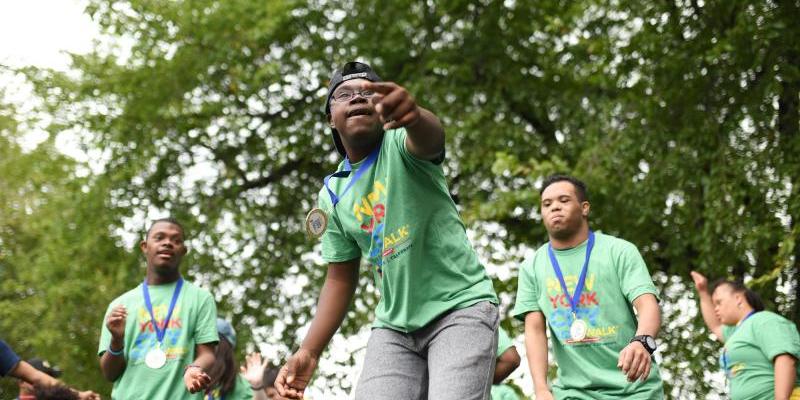
The first years of life are a critical time in a child’s development. All young children go through the most rapid and developmentally significant changes during this time. During these early years, the basic physical, cognitive, language, social, and self-help skills that lay the foundation for future progress are achieved according to predictable developmental patterns. Children with Down syndrome typically face delays in certain areas of development, so early intervention is highly recommended. It can begin any time after birth, but the sooner it starts, the better.
What is early intervention?

Early intervention is a systematic program of therapy, exercises, and activities designed to address developmental delays that may be experienced by children with Down syndrome or other disabilities. These services are mandated by a federal law called the Individuals with Disabilities Education Act (IDEA). The law requires that states provide early intervention services for all children who qualify, with the goal of enhancing the development of infants and toddlers and helping families understand and meet the needs of their children. The most common early intervention services for babies with Down syndrome are physical therapy, speech and language therapy, and occupational therapy. The overarching goal of early intervention programs is to enhance and accelerate development by building on a child’s strengths and by strengthening those skills that are weaker in all areas of development.
When should early intervention start?
Early intervention should begin any time shortly after birth and usually should continue until the child reaches age three. An amendment to IDEA in 2004 allows states to have early intervention programs that may continue until the child enters, or is eligible to enter, kindergarten. The sooner early intervention begins, the better, but it’s never too late to start.
How can early intervention benefit a baby with Down syndrome?
Development is a continuous process that begins at conception and proceeds stage by stage in an orderly sequence. There are specific milestones in each of the four areas of development (gross and fine motor abilities, language skills, social development, and self-help skills) that serve as prerequisites for the stages that follow. Most children are expected to achieve each milestone at a designated time, also referred to as a “key age,” which can be calculated in terms of weeks, months, or years. Because of specific challenges associated with Down syndrome, babies will likely experience delays in certain areas of development. In monitoring the development of a child with Down syndrome, it is more useful to look at the sequence of milestones achieved, rather than the age at which the milestone is reached.
| Milestone | Range for Down Syndrome | Typical Range |
|---|---|---|
| Sits Alone | 6-36 months | 5-9 months |
| Crawls | 8-22 months | 6-12 months |
| Stands | 1-3.25 years | 8-17 months |
| Walks Alone | 1-4 years | 9-18 months |
| First Word | 1-4 years | 1-2 years |
| Two Word Phrases | 2-7.5 years | 15-32 months |
| Responsive Smile | 1-5 months | 1-3 months |
| Finger Feeds | 10-24 months | 7-15 months |
| Uses Spoon | 13-39 months | 12-20 months |
| Bowel Control | 2-7 years | 16-42 months |
| Drinks from Cup (unassisted) |
12-32 months | 9-18 months |
| Dresses Self (unassisted) |
3.5-8.5 years | 3.25-5 years |
What are the types of early intervention therapies, and how does each type address specific aspects of a baby’s development?

Physical therapy focuses on motor development. For example, during the first three to four months of life, an infant is expected to gain head control and the ability to pull to sitting positions (with help) with no head lags and enough strength in the upper torso to maintain an erect posture. Appropriate physical therapy may assist a baby with Down syndrome, who may have low muscle tone, in achieving this milestone.
Before birth and in the first months of life, physical development remains the underlying foundation for all future progress. Babies learn through interaction with their environment. In order to learn, therefore, an infant must have the ability to move freely and purposefully. An infant’s ability to explore his or her surroundings, reach and grasp toys, turn his or her head while watching a moving object, or roll over and crawl are all dependent upon gross as well as fine motor development. These physical, interactive activities foster understanding and mastery of the environment, stimulating cognitive, language, and social development.
Another long-term benefit of physical therapy is that it helps prevent compensatory movement patterns that individuals with Down syndrome are prone to developing. Such patterns can lead to orthopedic and functional problems if not corrected.
Speech and language therapy is a critical component of early intervention. Even though babies with Down syndrome may not say their first words until two or three years of age, there are many pre-speech and pre-language skills that they must acquire before they can learn to form words. These include the ability to imitate and echo sounds; turn-taking skills (learned through games like “peek-a-boo”); visual skills (looking at the speaker and objects); auditory skills (listening to music, speech, or speech sounds for lengthening periods of time); tactile skills (learning about touch, exploring objects in the mouth); oral motor skills (using the tongue, moving the lips); and cognitive skills (understanding object permanence and cause and effect relationships).
A speech and language therapist can help with these and other skills, including breastfeeding. Because breastfeeding employs the same anatomical structures used for speech, it can help strengthen a baby’s jaw and facial muscles and lay the foundation for future communication skills.

Occupational therapy helps children develop and master skills for independence. Occupational therapy can help with abilities such as opening and closing things, picking up and releasing toys of various sizes and shapes, stacking and building, manipulating knobs and buttons, experimenting with crayons, etc. Therapists also help children learn to feed and dress themselves and teach them skills for playing and interacting with other children.
Early intervention can also prevent a child with Down syndrome from reaching a plateau at some point in development. The overarching goal of early intervention programs is to enhance and accelerate development by building on a child’s strengths and by strengthening those skills that are weaker in all areas of development.
How can parents benefit from early intervention programs?
Programs of early intervention have a great deal to offer to parents in terms of support, encouragement, and information. The programs teach parents how to interact with their infant or toddler, how to meet their child’s specific needs, and how to enhance development.
How do I sign up for early intervention services?
Each state has its own set of laws governing early intervention services. Information on the process for each state can be found here. Early intervention services are individualized to meet the specific needs of each individual baby based on assessments. The caseworker, therapists, and family will determine areas of focus and set goals based on developmental milestones. These will be recorded in a document called the Individualized Family Service Plan (IFSP).
Who pays for early intervention?
The evaluation to determine whether your child is eligible for early intervention is free of charge if performed by a state-authorized entity. No child deemed eligible can be denied services based on ability to pay, but insurance companies may be billed and/or a sliding scale payment may be required, depending on the state. Parents should check with their state’s early intervention center for information about authorized service providers and financial obligations. Frequently, there is little or no cost to parents for these services.
Individualized Family Service Plan (IFSP)
An Individualized Family Service Plan (IFSP) is a written document that outlines the early intervention services that a child will receive when found eligible for early childhood special education services. IFSPs are for children ages birth until three. All children receiving early intervention services under IDEA- Part C must have an IFSP, but specific guidelines for the IFSP vary from state to state.
What happens after age 3?
The Individuals with Disabilities Education Act (IDEA), which regulates early intervention, also mandates that local school districts provide a free, appropriate, public education for preschool-age children with disabilities starting at the age of three, unless doing so would be inconsistent with state law or practice or the order of any court respecting the provision of public education to children between the ages of three and five.
Additional Resources
External Resources
- Center for Parent Information and Resources
CPIR is a central source of information on preadolescents and teens with disabilities. It features a clear and detailed guide to IDEA, the law authorizing early intervention services and special education, and State Resource Sheets to help you connect with disability agencies and organizations in your state. - Division for Early Childhood of the Council for Exceptional Children
One of 17 divisions of the Council for Exceptional Children, this organization supports policies and practices that support families and enhance development in especially young children with disabilities and learning delays. - The Early Childhood Technical Assistance Center
ECTA supports the national implementation of the Individuals with Disabilities Education Act (IDEA) by working with each state to provide technical assistance for children with disabilities and their families. The website provides a list of early intervention programs by state.
Books
-
Early Communication Skills for Children with Down Syndrome: A Guide for Parents and Professionals, Libby Kumin, Woodbine House, 2012
This book shows parents how they can support and encourage their child’s speech and language development from birth to age 6. Caregivers learn how to work through characteristic challenges, including hearing loss, intelligibility issues, apraxia (difficulty planning oral-motor movements), or a slower pace of development.
-
Fine Motor Skills for Children with Down Syndrome: A Guide for Parents and Professionals, Maryanne Bruni, Woodbine House, 2016
This book describes how the characteristics of Down syndrome can impact the acquisition and progression of fine motor skills and presents a thorough overview of the building blocks of fine motor development, from infancy through to adulthood. -
Gross Motor Skills for Children with Down Syndrome: A Guide for Parents and Professionals, Patricia Winders, Woodbine House, 2014
In parent-friendly language, the author explains the many physiological reasons that children with Down syndrome experience delays in their gross motor development and presents a physical therapy treatment plan from birth to age 6.







